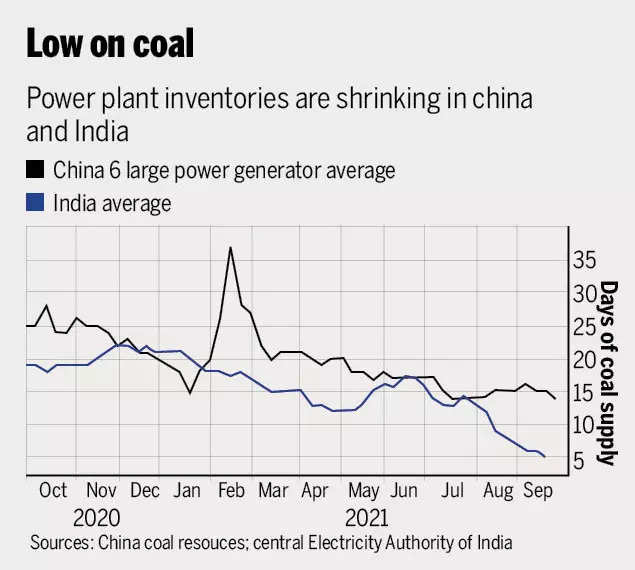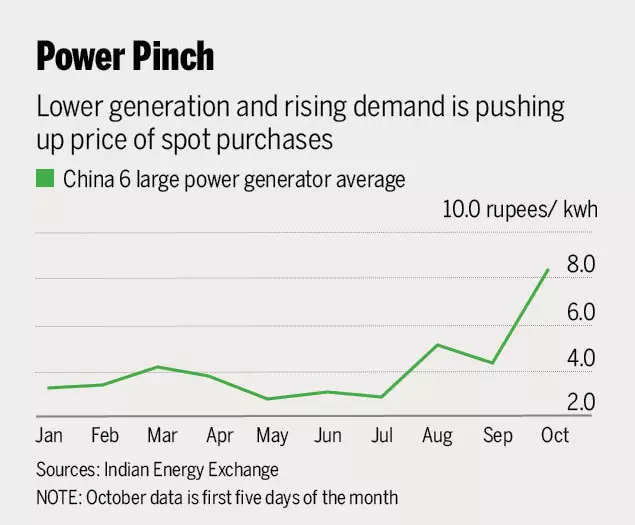On an average, most of the power stations had only 3-4 days of coal. This is far below government guidelines that recommend a minimum of 2 weeks’ supply.
Coal accounts for more than 70 percent of India’s electricity generation, and nearly three-quarters of the fossil fuel is mined domestically.

What are the reasons for the decline in inventory?
According to the Central Electricity Authority (CEA), out of the total power stations, 17 had zero quantity stock, while 21 of them had 1 day’s stock, 16 had 2 days’ coal and 18 of them had 3 Coal stock for the day was left. figures.
Out of total 135 plants, 107 did not have stock for more than 1 week.
Electricity generation fuels coal and natural gas are seeing their prices rise globally.
With the resumption of economic and industrial activities as the second wave of the COVID-19 pandemic hits, electricity demand has also witnessed a significant jump. This has resulted in a severe shortfall in the supply of coal and liquefied natural gas (LNG).
Not only in India but other countries are also facing crisis.
There seems to have been a sudden jump in demand for energy, which has driven prices up. However, major coal producing countries have failed to increase supply to meet their demand.
In addition, high prices in the global markets have also prevented India from importing coal to meet the domestic market demand.
India’s coal reserves
India is the second largest producer and consumer of coal in the world after China. It has the fourth largest coal reserves globally.
The total estimated reserves of coal in 2020 were 344.02 billion tonnes, an increase of 17.53 billion tonnes over the same period in 2019.
In percentage terms, there has been an increase of 5.37 percent in the total estimated coal reserves during the year 2020 as compared to the previous year.
The top three states with the highest coal reserves in India are Jharkhand, Odisha, Chhattisgarh, which account for about 70 percent of the country’s total coal reserves.
data from ministry of coal This shows that the majority of the total coal is consumed for power generation.
Domestic prices remained stable
More than 80 percent of India’s coal production is done by the state-owned Coal India.
Domestic coal prices in India are largely determined by it.
However, the company has kept the prices stable since last year, even as global prices are rising.
Asia’s coal price benchmark has hit record highs in recent days, fueled by global demand for power generation fuels as economies open up. A major power crisis in China is the latest to drive global demand for the fuel.

The lowest electricity tariff caused the crisis?
According to the website Globalpetrolprices.com, electricity rates in India are set by the respective states and are among the lowest in the world.
State-run distribution companies have absorbed higher input costs to keep tariffs stable.
This has left many companies deeply indebted, with cumulative liabilities running into the billions of dollars.
The strained balance sheets of companies have consistently delayed payments to power producers, often affecting cash flows and discouraging further investments in the power generation sector.
In addition, power producers who are locked into long-term agreements with distribution utilities often cannot pass on higher input costs unless clauses are included in their contracts.
This adds to their cost pressure.
Heavy monsoon added to the difficulties
Incessant heavy monsoon rains, especially in central and eastern India, have led to heavy flooding of mines.
Some major logistics routes have also been affected by this.
Any recovery will depend on the weather – rain needs to stop to allow mines to ramp up operations and allow coal trucks to resume deliveries.
Power crisis is not limited to India
Not only India but also China and Europe are facing the shortage of supply.
China – the largest consumer of coal globally – is in the grip of severe shortages of both coal and electricity.
Coal is the most important commodity transported by rail, accounting for 50 percent of the tonnage and 42 percent of the ton-kilometers.
Most areas were experiencing power cuts and blackouts. Many factories have also temporarily halted production, adding to the woes of an already slowing economy.
As a result, factory activity unexpectedly shrank in September for the first time since February 2020.
Similarly, energy costs in the European Union have skyrocketed.
European governments are trying to protect residential and small business customers from the full force of rising energy prices on utility bills through price caps, rebates and tax cuts.
who won, who lost
Shares of NTPC Ltd, Tata Power and Torrent Power and Coal India have risen strongly in recent weeks due to rising power demand.
However, NTPC may come under pressure if it is not allowed to hike prices amid shortages.
spot prices of electricity sold through Indian Energy Exchange The average jumped more than 63 per cent year-on-year in September to Rs 4.4 ($0.06) per kilowatt hour in September and hit Rs 13.95 on Wednesday, according to official data.

Will India’s crisis affect global coal markets?
India meets about three-quarters of its electricity demand from locally produced coal, and most of the rest is imported from countries including Indonesia, South Africa and Australia.
In fact, India is the second largest importer of coal.
A report by rating agency Crisil expects Australian and Indonesian thermal coal prices to rise for the remainder of this fiscal year due to lack of supply and high demand from China and elsewhere.
What is the government doing
Center amended rules to allow 50 per cent sale of coal from private mines. This will be applicable to both private and public sector captive mines.
With this amendment, the government has paved the way for releasing excess coal in the market by utilizing the mining capabilities of captive coal and lignite blocks, which is only partially due to limited production of coal to meet their captive needs. was actually being used.
Availability of additional coal will reduce the pressure on power plants and will also help in import-substitution of coal.
Coal stock expected to rise
Coal Secretary Anil Kumar Jain told news agency Bloomberg that Coal India is seeking to increase the daily coal supply from 1.7 million tonnes to 1.9 million tonnes by mid-October.
Government and industry are working to closely monitor stocks, and may move again to divert supply from industrial users such as aluminum and cement manufacturers to prioritize power generation.
A Coal India official also told news agency PTI that the power plants did not lift coal from CIL from October last year to February this year.
He said, “The power plants used up their coal reserves and did not replenish them. They did not follow the CEA guidelines of storing coal for 22 days. With the increase in demand for electricity, the demand for fuel also increased. ”
SN Tiwari, Director Marketing of the Company had said, “The Company is responsive to the importance of improving coal stocks at Thermal Power Stations. We are resuming our efforts to restore normalcy at the earliest by raising additional quantities. There’s more than just the supply. Right now.”
Power Minister denies lack of
dismiss the report of shortage of coal Union Energy Minister RK Singh said that there is no coal crisis in India like China and the country is in a position to meet the growing demand for coal.
Emphasizing that the increase in power demand is a positive sign for the country’s economy, Singh told news agency ANI, “The demand for coal has increased and we are meeting this demand. We will further increase the demand.” are in a position to meet the growth.
He also said that a sharp jump in energy demand is actually a good sign of economic recovery.
(with inputs from agencies)
.